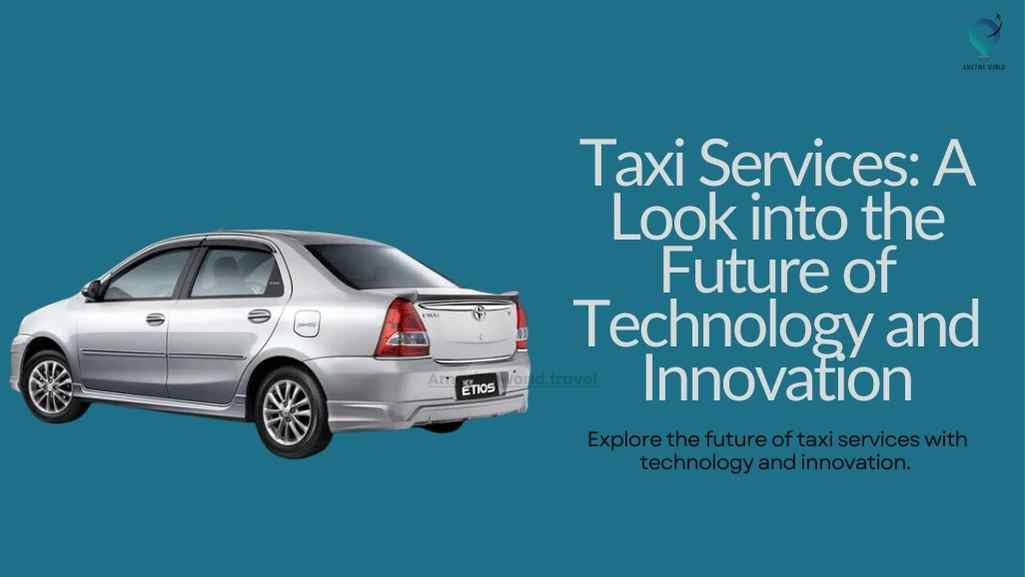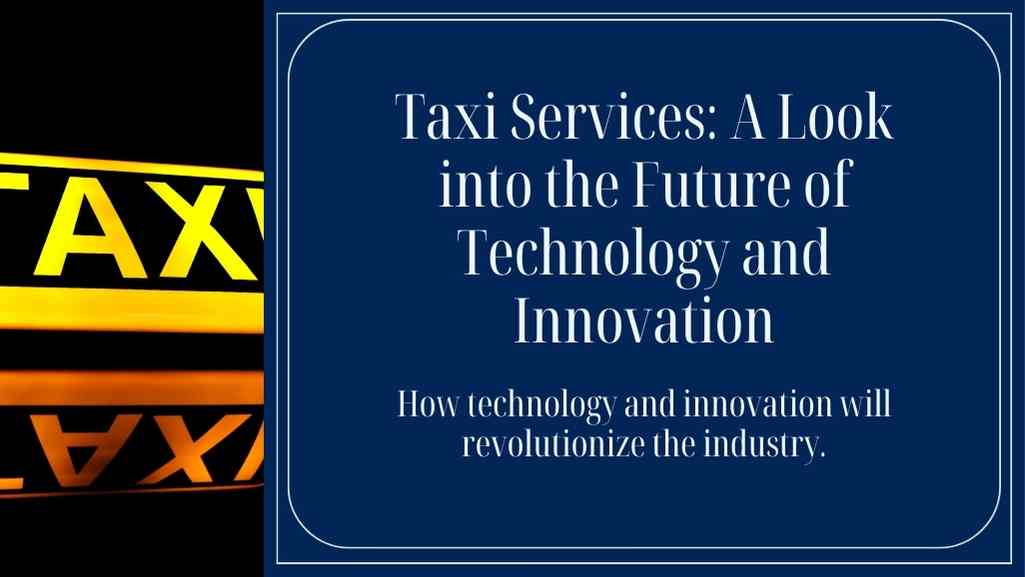Taxi Services: A Look into the Future of Technology and Innovation
Are you seeking an exciting adventure into the future of transportation? In today’s fast-paced world, taxi services are no longer just about waving down a cab on the street. With the ever-evolving technology and the rise of ride-sharing apps like Uber and Lyft, we’re entering a new era of convenience and innovation in the taxi industry.
This journey delves into the transformation of taxi services, where technology, innovation, and the latest mobility solutions meet, bringing you eco-friendly electric vehicles, autonomous taxis, and more. Get ready to explore the fascinating world of “Taxi Services: A Look into the Future of Technology and Innovation.
Whether you’re a passenger, a driver, or simply curious about the future of transportation, this article is your ticket to understanding the revolution in taxi services. We’ll discuss the latest trends and developments, the challenges and opportunities, and how the industry is balancing tradition with innovation. So, hop on board, and let’s navigate the exciting road ahead!
Overview of the Taxi Market
The global taxi market is a dynamic industry that has been experiencing substantial growth and transformation in recent years. As of 2020, the market was valued at $69.18 billion, and it is expected to reach $120.89 billion by 2027, representing a remarkable Compound Annual Growth Rate (CAGR) of 12.3% from 2020 to 2027. This growth is driven by various factors, including technological advancements and changing consumer preferences.
Looking for the best Car Rental service for your next travel Jouney? Therefore, we recommend you book your car rental from DiscoverCars.com – Official Website
Market Trends and Growth Factors
- CAGR from 2020-2024: From 2020 to 2024, the taxi industry is expected to witness a CAGR of 9.22%. This consistent growth is a testament to the increasing demand for taxi services worldwide.
- Taxi Dispatch Solutions: Taxi dispatch solutions have played a significant role in the industry, capturing a substantial 40% market share in 2018. Several factors have contributed to the popularity of taxi booking software, including the ease of booking and reduced fares. These innovations have made hailing a taxi more convenient and cost-effective for consumers.
- Smartphone Penetration: The widespread adoption of smartphones in countries like China, India, and Vietnam has revolutionized the way people access taxi services. With the convenience of mobile apps, consumers can book taxis at their fingertips, which has boosted the growth of taxi companies operating on the dispatch system. This trend has also enabled taxi businesses to expand their market share.
- Asia-Pacific Dominance: The Asia-Pacific region holds a significant share of the global bike and taxi market, accounting for over 70% of the market. Several factors contribute to this dominance, including lower taxi fares and increased traffic congestion compared to other transportation options. The demand for bike and taxi services, often powered by taxi dispatch software, has surged in this region.
The Current State of Taxi Services
The traditional taxi industry, a once-dominant mode of transportation, is currently undergoing a significant transformation in response to changing consumer expectations and emerging technologies. Here, we delve into the current state of taxi services and the challenges and opportunities they face in the modern landscape.
Traditional Taxi Industry:
- Legacy Service Model: Traditional taxi services have long been associated with hailing a cab on the street or making a phone call to a local taxi company. These services have provided valuable transportation options for many years.
- Challenges and Limitations: However, the traditional taxi industry faces several challenges that have impacted its popularity. These challenges include inconsistent service quality, varying pricing models, limited availability, and potential disputes over fares. Such limitations have led to a decline in consumer trust and demand.
Emerging Technologies and Innovations: The evolving landscape of the taxi industry is characterized by several notable developments:
- Ride-sharing apps: The emergence of ride-sharing apps, exemplified by companies like Uber and Lyft, has revolutionized how people access taxi services. These apps have made it incredibly easy to book rides using a smartphone, effectively eliminating the need to hail a taxi on the street or make phone calls.
- GPS and Navigation Systems: The widespread availability of GPS and advanced navigation systems has enhanced the efficiency of taxi services. Passengers and drivers can now rely on these technologies to navigate unfamiliar routes, ensuring they reach their destinations more quickly and accurately.
- Advances in Vehicle Technology: Another significant shift involves the integration of modern vehicle technologies. Electric vehicles (EVs) are being incorporated into taxi fleets, offering environmental benefits through reduced carbon emissions. Moreover, the operational cost savings associated with EVs are appealing to taxi operators.
Enhancing the Passenger Experience: In addition to improving the booking process and transportation efficiency, technology is enhancing the overall passenger experience:
- In-Car Entertainment and Connectivity: Modern taxis are equipped with in-car entertainment systems and connectivity options. Passengers can enjoy music, videos, and even Wi-Fi during their rides, making their journeys more enjoyable and productive.
- Safety and Convenience Features: Advanced safety features like dashcams, driver identification systems, and real-time tracking have become standard in many taxis. These features enhance passenger safety and provide peace of mind.
Environmental Sustainability: Taxi companies are increasingly adopting eco-friendly transportation options. Electric vehicles and hybrid models are becoming common in taxi fleets, reducing air pollution and decreasing dependence on fossil fuels.
Challenges and Opportunities: The current state of taxi services is marked by both challenges and opportunities:
- Regulatory and Legal Issues: The taxi industry is subject to various regulations aimed at ensuring safety, fair pricing, and passenger protection. However, the rapid integration of technology has created a need for updated regulations that address new business models like ride-sharing and autonomous taxis.
- Competition and Innovation: Traditional taxi services now compete with ride-sharing companies and are exploring innovative approaches, such as app-based dispatch systems. These innovations are essential to remaining relevant in a rapidly changing market.
Technology Transforming the Taxi Industry
Ride-sharing Apps: Ride-sharing apps like Uber and Lyft have revolutionized the industry by connecting riders with drivers through user-friendly mobile applications. This innovation has made booking a ride as easy as tapping a smartphone screen, eliminating the need to hail a taxi on the street.
GPS and Navigation Systems: The widespread availability of GPS and advanced navigation systems has made it easier for both passengers and drivers to navigate unfamiliar routes. This technology ensures that riders reach their destinations efficiently and without unnecessary detours.
Advances in Vehicle Technology: The adoption of electric vehicles (EVs) in taxi fleets not only reduces carbon emissions but also lowers operating costs. These innovations are a win-win for both the environment and taxi operators, demonstrating that technology can drive sustainability.
Innovations in Passenger Experience
In-Car Entertainment and Connectivity: Technology is enhancing the passenger experience by providing in-car entertainment systems and connectivity options. Riders can now enjoy music, video, and Wi-Fi during their trips, making their journeys more enjoyable and productive.
Safety and Convenience Features: Modern taxis are equipped with safety features like dashcams, driver identification, and real-time tracking. These innovations contribute to safer rides, providing peace of mind for passengers.
Ride-hailing and Autonomous Taxis: A Glimpse into the Future of Taxi Services
The taxi industry is on the brink of a transformative change with the emergence of autonomous (self-driving) taxis. These vehicles have the potential to revolutionize the way we think about transportation and offer numerous benefits, but they also come with their own set of challenges and complexities. Here, we explore the development of autonomous taxis, the potential advantages they bring, and the hurdles that need to be overcome.
Development of Autonomous Taxis
A Game-Changing Prospect: The development of autonomous taxis represents a pivotal moment in the transportation industry. Autonomous taxis, equipped with advanced sensors, machine learning algorithms, and real-time data processing, have the potential to be a game-changer by providing cost-effective and convenient transportation.
- Reducing Human Driver Dependency: One of the primary distinctions of autonomous taxis is the reduction of human drivers. These vehicles rely on cutting-edge technology to navigate, make decisions, and ensure passenger safety. As a result, they have the potential to mitigate the inherent risks associated with human error and fatigue.
- 24/7 Service: Autonomous taxis can operate round the clock, offering 24/7 service. This can significantly increase the availability and accessibility of transportation for consumers, especially in urban areas where traffic congestion and parking challenges are common.
Benefits and Challenges
While the advent of autonomous taxis holds great promise, several challenges must be addressed to realize their full potential:
- Regulatory Concerns: The development and deployment of autonomous taxis face regulatory hurdles. Governments and transportation authorities need to establish guidelines and rules to ensure the safety and reliability of self-driving vehicles. This includes addressing liability issues and determining the conditions under which autonomous taxis can operate.
- Public Trust: Building public trust in autonomous technology is crucial. Passengers need to have confidence in the safety and reliability of self-driving taxis. This involves not only technological advancements but also public awareness campaigns and education.
- Impact on Employment: The introduction of autonomous taxis raises concerns about the impact on employment in the taxi industry. As human drivers become less necessary, there is the potential for job displacement. Strategies for transitioning and retraining affected workers are essential to address these challenges.
- Data Security and Privacy: Autonomous vehicles rely heavily on data and connectivity. Ensuring the security and privacy of sensitive passenger data is paramount to prevent unauthorized access and protect against potential cyber threats.
- Infrastructure and Technology Investment: The development and deployment of autonomous taxis require significant investments in infrastructure, including the installation of intelligent transportation systems and the integration of vehicle-to-infrastructure (V2I) and vehicle-to-vehicle (V2V) communication networks.
Regulatory and Legal Issues in the Taxi Industry: Balancing Tradition and Innovation
The taxi industry has long been subject to a framework of regulations aimed at ensuring safety, fair pricing, and passenger protection. However, the rapid integration of technology and new business models, including ride-sharing, electric vehicles, and autonomous taxis, has created a pressing need for updated regulations. Striking the right balance between preserving tradition and embracing innovation is crucial for the industry’s evolution.
Current Regulations
- Ensuring Passenger Safety: Current regulations governing the taxi industry are primarily designed to ensure passenger safety. These regulations include driver background checks, vehicle inspections, and requirements for insurance coverage. They are put in place to minimize risks and safeguard the interests of passengers.
- Fare Regulation: Fair pricing is another key aspect of current regulations. Many jurisdictions have established rules to prevent price gouging and ensure that passengers are charged reasonable and consistent fares. This is particularly important to protect consumers from unfair practices.
- Market Entry and Licensing: Regulations often dictate how taxis can enter the market and how many are allowed to operate in a given area. This is done to maintain a balance between supply and demand and avoid oversaturation of the market.
Need for Updated Regulations
- Ride-sharing and App-Based Services: The rise of ride-sharing services, such as Uber and Lyft, has blurred the lines between traditional taxis and private transportation. These app-based services require new regulations that account for their unique business models, including driver-partners who use their personal vehicles.
- Electric Vehicles (EVs): The adoption of electric vehicles in taxi fleets is another area that demands updated regulations. EVs offer environmental benefits and cost savings, but regulations must address charging infrastructure, vehicle standards, and incentives for operators to make the transition.
- Autonomous Taxis: The introduction of autonomous taxis presents a whole new set of challenges. Regulations need to address the safety of self-driving vehicles, liability in the event of accidents, and the establishment of guidelines for autonomous taxi operations.
- Innovation and Competition: The taxi industry is facing increased competition from new and innovative transportation solutions. Regulations need to foster fair competition while maintaining safety standards. This requires a delicate balancing act between protecting traditional taxi services and allowing new entrants to thrive.
- Consumer Protections: As technology evolves, regulations must also adapt to ensure that consumers’ rights and data privacy are safeguarded. This includes addressing issues related to data security and transparency in pricing and service quality.
- Accessibility and Inclusivity: Regulations should address accessibility for all passengers, including those with disabilities. Ensuring that new transportation models accommodate the needs of all individuals is a priority.
Challenges and Concerns in the Taxi Industry
The taxi industry, like any other, is not without its share of challenges and concerns. From technological disruptions to ethical considerations, these issues impact the industry’s evolution and adaptation to changing consumer demands. Here, we explore some of the key challenges and concerns faced by the taxi sector:
- Technological Disruption: The rapid rise of ride-sharing services and the development of autonomous vehicles are fundamentally altering the industry. Traditional taxi services face intense competition from innovative app-based platforms and must adapt to stay relevant.
- Regulatory Complexity: The regulatory landscape is becoming increasingly complex. Traditional regulations need to be updated to address the unique aspects of ride-sharing, electric vehicles, and autonomous taxis. Striking a balance between safety and innovation is a formidable challenge.
- Job Displacement: The introduction of autonomous vehicles raises concerns about job displacement in the taxi industry. As self-driving technology progresses, drivers may face challenges in maintaining their livelihoods. Transitioning and retraining opportunities will be essential to address this issue.
- Public Trust and Safety: Building public trust in emerging technologies and ensuring passenger safety is a top priority. The success of ride-sharing and autonomous taxis hinges on passenger confidence in the safety and reliability of these services.
- Data Security and Privacy: As technology collects more data about passengers and drivers, ensuring data security and privacy is a significant concern. Protecting sensitive information from cyber threats and unauthorized access is paramount.
- Ethical and Social Considerations: The rise of ride-sharing has raised ethical questions regarding labor practices, pricing models, and the impact on traditional taxi drivers. Finding ethical solutions and ensuring social inclusivity in the evolving industry is a complex challenge.
Conclusion: The Future of Taxi Services
The taxi industry is at a turning point, facing big changes and important choices. On one side, exciting new technologies are transforming how we get around. Ride-sharing apps and self-driving cars promise convenience and efficiency. But on the other side, there are challenges to overcome.
The rules and regulations that have kept taxi services safe and fair need to be updated to fit the modern world. This is important to make sure new services like ride-sharing and self-driving cars are safe and follow the rules.
A big concern is jobs. As technology grows, some taxi drivers may find it hard to keep their jobs. We need to find ways to help them learn new skills and find new work.
Safety and trust are very important too. People need to feel safe when they use new services. We also need to keep their personal information safe from hackers.
We must also think about what’s right and fair. New technology should not hurt the people who have been working in the taxi industry for a long time. Everyone should have a chance to succeed.
In the future, the taxi industry will be a mix of old and new, with new technology making things better. It will depend on how well we can adapt and make sure that it’s safe, fair, and good for everyone. By doing this, the taxi industry can have a bright and exciting future.
How much did you like Our Detailed Top 12 Ride-Sharing Apps for Safe Travel in 2023? Review Also, please share these Blogs with your friends on social media.
Recommended
- Taxi scams in the USA and Europe
- 10 Common Taxi Scams and How to Avoid Them
- 10 Essential Taxi Safety Tips
- How To Calculate Your Taxi Fare
- How Fraudsters Take Ride-Hailing Apps

Meet David Hoper, a passionate travel Blog writer with 7+ years of experience in travel content. Through his exemplary storytelling and engaging narratives, he shares his experiences and brings destinations to life. With a keen eye for detail and a love for exploration, he has cultivated a diverse portfolio of travel blogs that inspire and inform readers worldwide.










